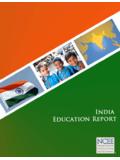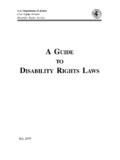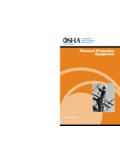Transcription of An Overview of Alternative Education - NCEE
1 An Overview of Alternative EducationLaudan Y. AronThe Urban InstituteJanuary 2006 First in a series of papers on Alternative educationAn Overview of Alternative EducationLaudan Y. AronThe Urban InstituteJanuary 2006 First in a series of papers on Alternative educationThis paper was prepared for and funded by the department of Labor, Employment, and Training Administration. This paper is the first in a series published in 2006 by the National Center on Education and the Economy using funds from DOL Grant #AF-14604-05-06. The nonpartisan Urban Institute publishes studies, reports, and books on timely topics worthy of public of ContentsINTRODUCTION ..1 WHAT DO WE MEAN BY Alternative Education ?.. 3 WHAT DO WE KNOW ABOUT THE STUDENTS WHO NEED Alternative Education ? ..8 WHAT DO WE KNOW ABOUT CURRENT Alternative Education PROGRAMS? ..10 WHAT KINDS OF Alternative Education PROGRAMS EXIST? ..11 WHAT ARE THE NOTEWORTHY ATTRIBUTES OF HIGH QUALITY Alternative Education PROGRAMS?
2 11 HOW CAN RECENT RESEARCH ON YOUTH PROGRAMMING INFORM Alternative Education ?.. 13 WHAT NEW Alternative Education PROGRAMS AND INITIATIVES ARE UNDERWAY? ..16 WHAT OUTCOMES SHOULD Alternative Education PROGRAMS DEMONSTRATE?.. 18 WHAT CURRENT POLICIES AFFECT Alternative Education ? ..20 WHAT FUNDING SOURCES ARE AVAILABLE TO SUPPORT Alternative Education ? ..21 CONCLUSIONS .. 23 REFERENCES ..24 APPENDIX A: Promising Models of Alternative Education Programs.. 28 APPENDIX B: Sources of Noteworthy Attributes of Alternative Programs/Schools .. 31 January 2006 NCEE iiiAN Overview OF Alternative EDUCATIONJ anuary 2006 NCEE 1An Overview of Alternative Education ..there is another more pressing challenge before has the potential to damage our ability to compete and succeed in a global economy. That challenge is the deterioration of our Education rates are hovering only around seventy percent enough of America s next generation are learning the skills required in the 21st Century and will soon be looking to us to provide them job training.
3 Eighty percent of the fastest growing jobs require Education and training beyond high school. These are the jobs that will drive innovation in the world economy and determine which country will lead that economy. Assistant Secretary Emily Stover DeRocco In a speech to the National Association of Workforce Boards March 4, 2005 Washington, the publication of A Nation At Risk in 1983 that sounded alarms about the quality of the nation s schools, the United States has been on a path toward restructuring its Education system. In 1990, the bipartisan Commission on the Skills of the American Workforce led by two former Secretaries of the department of Labor noted in its report, America s Choice: High Skills or Low Wages!, that the United States, unlike all the other countries that it competes with economically, does not have a system of Education standards identifying what all students need to know and do to succeed in the 21st century economy. Since then, states and school districts have been focusing their efforts on adopting high academic standards, improving accountability, and achieving excellence.
4 The No Child Left Behind Act, proposed by President Bush and passed by the Congress in 2001, has continued to push to strengthen our nation s schools through a system of state standards, tests and a national accountability system, and a targeted effort to help low-performing schools and estimates put the number of youth who are not in school, do not have a diploma, and not working at million (Aron et al. 2003, p. 5); however, little attention is being paid to the need for scaled efforts to reconnect these dropouts to Education options that prepare them for success in the economy of the future (Harris 2005, p. 2). These youth need access to high quality Alternative Education and training opportunities to equip them to compete in today s labor Overview OF Alternative EDUCATION2 January 2006 NCEEHigh school completion rates peaked in 1969 at percent and have gradually declined to percent (Barton 2005, p. 2).1 The earning power of individuals with less than a high school Education (and even of high school graduates) has fallen continuously over the last several decades.
5 In 1971, male dropouts working full-time earned $35,087 (in 2002 dollars). By 2002, this figure had fallen 35 percent, to $23,903. According to the Bureau of Labor Statistics in its publication, Occupational Outlook, Winter 2004-2005, when an occupation has workers with different levels of Education , the worker with more Education is better able to compete for the job (Moncarz, R. and Crosby, O. 2004-2005, p. 6). The Outlook goes on to describe how individuals with a high school degree and some college or vocational training are more likely to be hired, to earn more when they start a job and over a lifetime, and to become supervisors. Clearly, a high school diploma and some form of post-secondary Education and training are now critical to succeeding in the new global economy of the 21st century. Alternative pathways to educational success are needed at every step of the way, ranging from essential early intervention and prevention strategies in the early years, to a multiplicity of high-quality Alternative options within mainstream K-12 systems at the middle and high school levels, and finally to opportunities outside of the mainstream for those who have been unable to learn and thrive in the general Education system.
6 The main focus of this review for the department of Labor is community- or district-based programs that have as their primary focus the re-engagement of out-of-school youth in learning in order to better prepare these youth to successfully enter high growth occupations and careers. Below we review some preliminary efforts to develop a typology and define Alternative Education , as well as several promising programs, models, and initiatives that provide out-of-school youth with real second chance opportunities. We then turn to the issue of how many out-of-school youth are involved in Alternative Education , how many need these options, and other evidence concerning youth who need access to Alternative Education programs. The final section discusses the current policy environment for Alternative Education , some of the funding streams available to support programs for out-of-school youth, and how underused funding streams might be tapped for this turning to these topics, it is important to keep in mind that youth do not disconnect from traditional developmental pathways (or high schools for that matter) 1 Congress acknowledged the severity of the dropout problem by including graduation rate accountability provisions in the NCLB legislation enacted in 2002.
7 Getting consensus on accurate graduation and dropout rates has typically been difficult as state and local Education systems use different methods; in fact, the National Center for Educational Statistics has recently developed a standard formula for calculating these rates that will be used to determine if states are meeting their Adequate Yearly Progress (AYP) goals on dropout and graduation Overview OF Alternative EDUCATIONJ anuary 2006 NCEE 3because of the failure of any one Likewise, reconnecting youth requires collaboration and coordination among multiple youth-serving systems: these certainly include school and youth employment and training programs, but also child protective service systems, the juvenile justice system, and a variety of health and human services agencies, such as mental health and substance abuse treatment agencies, crisis intervention centers, runaway and homeless youth shelters, and others. WHAT DO WE MEAN BY Alternative Education ?
8 The term Alternative Education in its broadest sense covers all educational activities that fall outside the traditional K-12 school system (including home schooling, GED preparation programs, special programs for gifted children, charter schools, etc.), although the term is often used to describe programs serving vulnerable youth who are no longer in traditional schools. Ironically, because they are often associated with students who were unsuccessful in the past, many Alternative schools are thought to be of much poorer quality than the traditional K-12 school system, and yet because they are challenged to motivate and educate disengaged students many Alternative Education programs are highly valued for their innovation and Common Core of Data, the department of Education s primary database on public elementary and secondary Education , defines an Alternative Education school as a public elementary/secondary school that addresses needs of students that typically cannot be met in a regular school, provides nontraditional Education , serves as an adjunct to a regular school, or falls outside the categories of regular, special Education or vocational Education ( department of Education 2002, Table 2, p.)
9 14). A definitive typology of the many types of Alternative Education schools and programs that fall within this rather broad definition has yet to be developed and accepted by the field. Aron and Zweig s review (2003, p. 20) discusses many dimensions of interest that could be used in the development of a typology including the target population, the program s purpose or focus, the physical setting relative to regular schools or other institutions such as residential treatment or juvenile justice facilities, the educational focus or credential offered, the administrative home or sponsor, and how it is funded. These are the many dimensions that distinguish Alternative programs from more traditional ones. A three-type typology 2 By traditional developmental pathways we mean that youth are generally connected to the Education , employment, or organizations that prepare them for a successful transition to Overview OF Alternative EDUCATION4 January 2006 NCEE developed by Mary Anne Raywid (1994, p.
10 26 31) is based on a program s goals as their distinguishing characteristic and has been described as follows: TYPE I schools offer full-time, multiyear, Education options for students of all kinds, including those needing more individualization, those seeking an innovative or challenging curriculum, or dropouts wishing to earn their diplomas. A full instructional program offers students the credits needed for graduation. Students choose to attend. Other characteristics include divergence from standard school organization and practices (deregulation, flexibility, autonomy, and teacher and student empowerment); an especially caring, professional staff; small size and small classes; and a personalized, whole-student approach that builds a sense of affiliation and features individual instruction, self-paced work, and career counseling. Models range from schools-within-schools to magnet schools, charter schools, schools without walls, experiential schools, career-focused and job-based schools, dropout-recovery programs, after-hours schools, and schools in atypical settings like shopping malls and museums.














